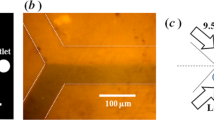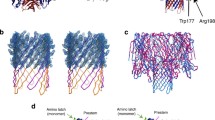Abstract
Staphylococcus aureus α-toxin forms ionic channels of large size in lipid bilayer membranes. We have developed two methods for studying the mechanism of pore formation. One is based on measurement of the ionic current flowing through a planar lipid membrane after exposure to the toxin; the other is based on measuring the release of the fluorescent complex Tb-Dipicolinic acid from large unilamellar vesicles under similar conditions.
Both methods indicate that the pore formation process is complex, showing an initial delay followed by non-linear kinetics. The power dependence of the pore formation rate on the toxin concentration in planar bilayers indicates that an aggregation mechanism underlies the channel assembly. Arrhenius plots, obtained with both techniques, show no deviation from linearity up to 50°C and the derived activation energies are found to be comparable to those for the binding and the lysis of rabbit erythrocytes by the same toxin.
The temperature dependence of the conductance induced in planar bilayers by a large number of toxin channels indicates that the pores are filled with aqueous solution. The analysis of single conductance events shows that a heterogeneous population of pores exist and that smaller channels are preferred at low temperature. We attribute this heterogeneity to the existence of pores resulting from the aggregation of different numbers of monomers.
Similar content being viewed by others
References
Arbuthnott JP, Freer JH, Billcliffe B (1973) Lipid-induced polymerization of Staphylococcal α-toxin. J Gen Microbiol 75:309–319
Bamberg E, Läuger P (1973) Channel formation kinetics of gramicidin A in lipid bilayer membranes. J Membr Biol 11:177–194
Bentz J, Düzgünes N, Nir S (1983) Kinetics of divalent cation induced fusion of phosphatidylserine vesicles; correlation between fusogenic capacities and binding affinities. Biochemistry 22:3320–3330
Bhakdi S, Füssle R, Tranum-Jensen J (1981) Staphylococcal α-toxin: oligomerization of hydrophilic monomers to form amphiphilic hexamers induced through contact with deoxycholate detergent micelles. Proc Natl Acad Sci USA 78: 5475–5479
Boheim G, Kolb HA (1978) Analysis of the multi-pore system of alamethicin in a lipid membrane. I. Voltage-jump current-relaxation measurements. J Membr Biol 39:99–150
Bukelew AR, Colacicco G (1971) Lipid monolayers. Interaction with Staphylococcal α-toxin. Biochim Biophys Acta 233:7–16
Cassidy P, Six AR, Harshman S (1974) Biological properties of Staphylococcal α-toxin. Biochim Biophys Acta 332: 413–425
Cassidy P, Harshman S (1976) Studies on the binding of Staphylococcal 125I-labelled α-toxin to rabbit erythrocytes. Biochemistry 15:2348–2355
Chen SC, Sturtevant JM (1981) Thermotropic behavior of bilayers formed from mixed-chain phosphatidylcholines. Biochemistry 20:713–718
Fraley R, Wilschut J, Düzgünes N, Smith C, Papahadjopoulos D (1980) Studies on the mechanism of membrane fusion: Role of phosphate in promoting calcium ion induced fusion of phospholipid vesicles. Biochemistry 19:6021–6029
Freer JH (1982) Cytolytic toxins and surface activity. Toxicon 20:217–221
Freer JH, Arbuthnott JP (1983) Toxins of Staphylococcus aureus. Pharmacol Ther 19:55–106
Freer JH, Arbuthnott JP, Bilcliffe B (1973) Effects of Staphylococcal α-toxin on the structure of erythrocytes membranes. J Gen Microbiol 75:321–332
Füssle R, Bhakdi S, Sziegoleit A, Tranum-Jensen J, Kranz T, Wellensiek HJ (1981) On the mechanism of membrane damage by Staphylococcus aureus α-toxin. J Cell Biol 91: 83–94
Harned S, Owen B (1958) The physical chemistry of electrolytic solutions. Reinhold, New York
Harshman S (1979) Action of staphylococcal α-toxin on membranes: some recent advances. Mol Cell Biochem 23: 142–152
Ikigai H, Nakae T (1984) The rate assay of alpha-toxin assembly in membrane FEMS. Microbiol Lett 24:319–322
Jain K, Wagner C (1980) Introduction to biological membranes. John Wiley and Sons, New York
Kleinberg ME, Finkelstein A (1984) Single-length and doublelength channels formed by nystatin in lipid bilayer membranes. J Membr Biol 80:257–269
Latorre R, Alvarez O, Verdugo P (1974) Temperature characterization of the conductance of the excitability inducing material channel in oxidized cholesterol membranes. Biochim Biophys Acta 367:361–365
Menestrina G (1986) Ionic channels formed by Staphylococcus aureus alpha-toxin: voltage dependent inhibition by di and trivalent cations. J Membr Biol 90:177–190
Montal M, Mueller P (1972) Formation of bimolecular membranes from lipid monolayers and a study of their electrical properties. Proc Natl Acad Sci USA 69:3561–3566
Nikaido H, Rosenberg Y (1981) Effect of solute size on diffusion rates through the transmembrane pores of outer membrane of Escherichia coli. J Gen Physiol 77:121–135
Pick U (1981) Liposomes with a large trapping capacity prepared by freezing and thawing of sonicated phospholipid mixtures. Arch Biochem Biophys 212:186–194
Tobkes N, Wallace BA, Bayley H (1985) Secondary structure and assembly mechanism of an oligomeric channel protein. Biochemistry 24:1915–1920
Author information
Authors and Affiliations
Rights and permissions
About this article
Cite this article
Belmonte, G., Cescatti, L., Ferrari, B. et al. Pore formation by Staphylococcus aureus alpha-toxin in lipid bilayers. Eur Biophys J 14, 349–358 (1987). https://doi.org/10.1007/BF00262320
Received:
Accepted:
Issue Date:
DOI: https://doi.org/10.1007/BF00262320




